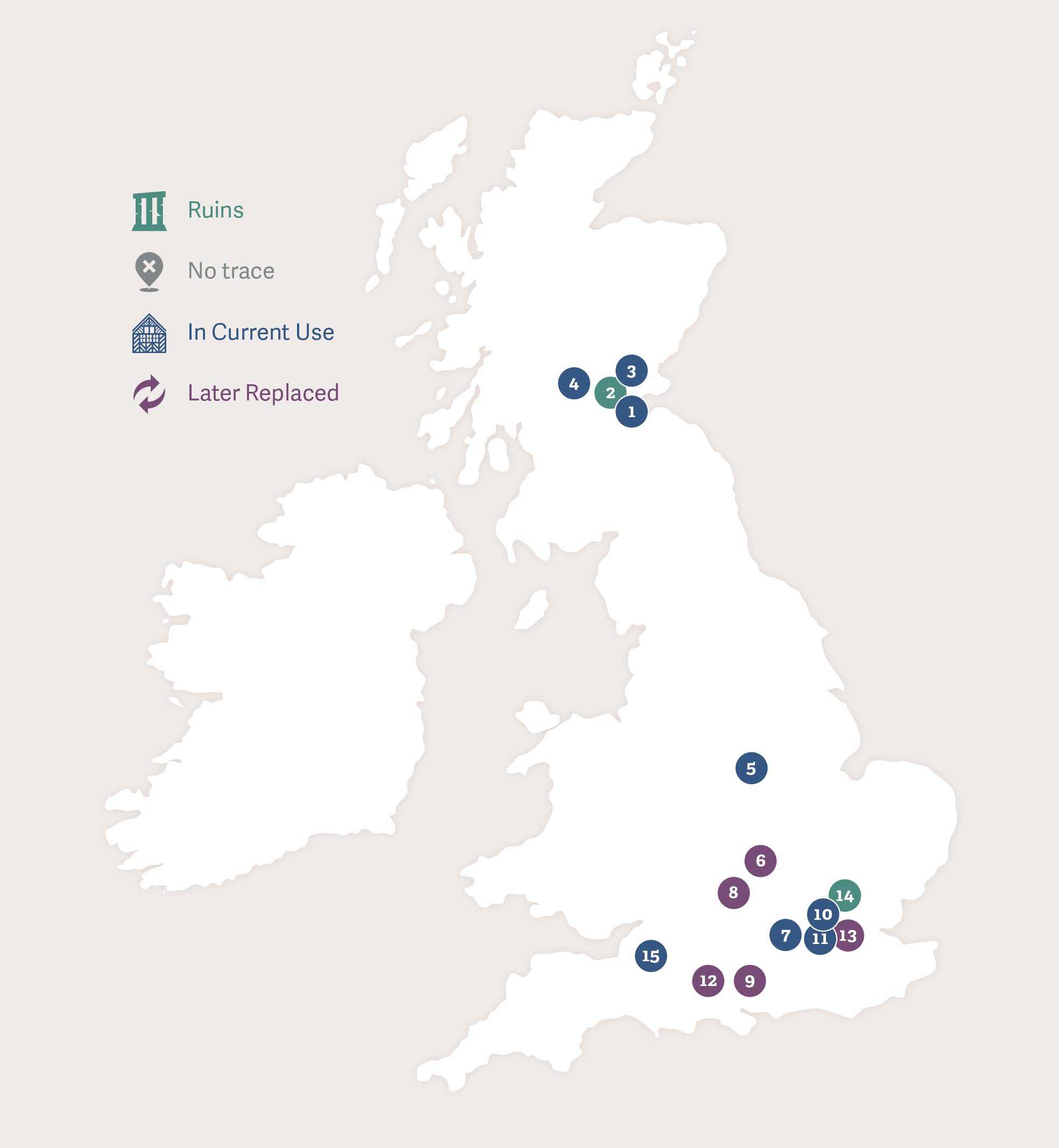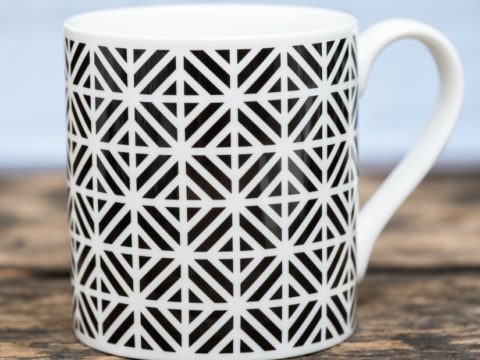Anne of Denmark: Processions & Pageants
Anne of Denmark travelled more widely within the British Isles and northern Europe than any Queen Consort before her, although there were many parts of Scotland and England that she never saw: like most monarchs, her travels were mainly in the central belt of Scotland, and the south-east of England.
The numbers against the places correspond to those on the map here and at the end of this article.
Anne was born at Skanderborg Castle, in the town of the same name in east Denmark. The castle, mediaeval in origin, had been rebuilt in the modern, Renaissance style by her father, in the years leading up to Anne’s birth. Within a few months, Anne, together with her older sister, Elizabeth, went to live with her maternal grandparents, the Duke and Duchess of Mecklenburg-Gustrow. The likelihood is that they travelled by ship to Mecklenburg, which is in the modern German region, Mecklenburg-Vorpommem. They returned to the Danish court when Anne was about five years old.
Aged fourteen, Anne set out from Copenhagen to be married to James VI of Scotland, but was driven back by storms, landing in Oslo. As Anne’s brother, Christian IV was king of both countries, this did not present any political problems, but left her with a logistical one – to travel on to Scotland, braving the winter weather, or to return home?
In the event, King James came to her, and they were married in Oslo in November 1589, before travelling back to Denmark. After further travels in Denmark and northern Germany, the couple set out for Scotland, arriving at Leith on 1st May 1590. Anne remained at Leith to recover her equilibrium after the sea voyage, then entered Edinburgh. She was crowned at Holyrood Abbey (1) on 17th May, 1590.
Holyrood had been the most important religious site in Edinburgh before the Reformation, and the modern palace adjoining it had largely been built by James IV and James V. The palace remains, significantly extended and beautified by Anne’s grandson, Charles II. Holyroodhouse Palace is the official Scottish residence of HM The Queen and can be visited.
Part of Anne’s feoffment (the lands bestowed on her for her maintenance as Queen of Scots) included the palace of Dunfermline (2). Dunfermline, in Fife, just north of the bridge that now crosses the Firth of Forth, had ancient royal and religious significance for Scottish Kings. It was there in 1070 that Malcolm III Canmore (Máel Coluim Caenn Mòr) probably married Margaret Atheling, the Saxon princess, and later saint. Queen Margaret founded the Benedictine Abbey there, and it is the burial place of both Malcolm and Margaret, as well many later Scottish kings, including Robert the Bruce (although his heart is at Melrose Abbey).
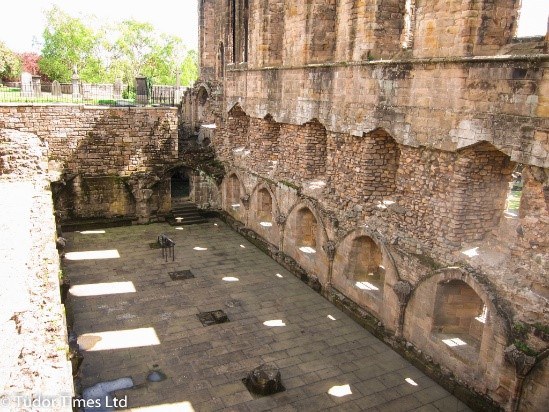
Anne liked Dunfermline, and, with the Abbey dissolved, reused the old abbey guest house to extend the royal palace. It was here that her son Charles (later Charles I) was born. The buildings are now ruins in the care of Historic Scotland and very easy to visit. The Abbey Church, somewhat reduced in size, remains the parish church and can be visited – it is a superb example of Norman architecture in Scotland.
Another of the Scottish palaces where Anne spent considerable amounts of time was Falkland Palace (3). This too, was once a twelfth century castle, but it was extensively remodelled by James V and his wife, Marie of Guise. It was also much favoured by Mary, Queen of Scots. Falkland was small, not large enough for the whole court, and was used more as a pleasure palace – pleasure largely being centred around hunting. Anne and her husband, James VI, hunted frequently, together or alone.
Today, it is one of the most delightful palaces of all to visit. The gardens are superb and the palace itself filled with Flemish tapestries and furniture of the sort that Anne and her predecessors would have used.
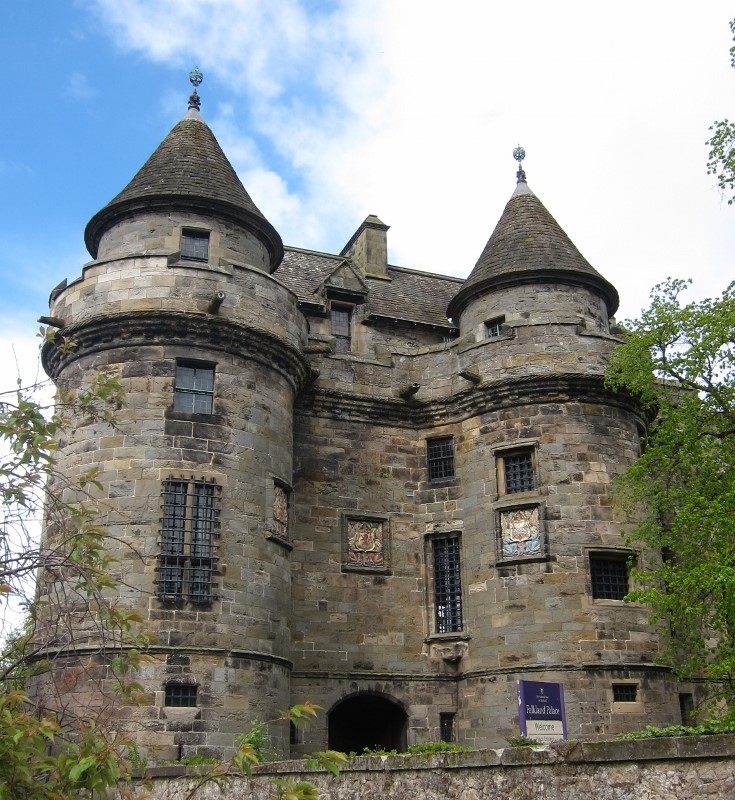
Whilst Falkland was for pleasure, Stirling Castle (4) was for defence. It was the place where James VI had been crowned, and where his mother, Mary, Queen of Scots, was kept safely by Marie of Guise before being secretly taken to France. For Anne, it became the scene of bitter memories. James decreed that, in the light of the risk of abduction of his heir (which given the events of James’ own youth was a perfectly rational fear) their son, Henry Frederick, was to be brought up at Stirling by the Earl of Mar. Anne was beside herself with grief at being parted from her son, although there was nothing to prevent her visiting him. In 1603, when James had left for England, Anne immediately went to Stirling and sought to take Henry away. The quarrel between her and the Mars became notorious.
Stirling was not just a defensive place, it was one of the most important castles in Scotland – overlooking the site of the battles of Bannockburn and Sauchieburn, it too, had been refurbished into a Renaissance palace by James V. Today, Stirling Castle is one of Historic Scotland’s busiest sites. The royal apartments have been decorated to show how they might have looked during their heyday during the regency of Marie of Guise.
In 1603, Anne became Queen of England as well as Scotland. She set out on a grand progress south to London, accompanied by her two eldest children, Prince Henry (now restored to her) and Princess Elizabeth (later famous as the Queen of Bohemia). She was met at Berwick by a bevy of ladies whom Sir Robert Cecil had decided ought to be her ladies-in-waiting and by his half-brother, Lord Burghley, President of the Council of the North. Anne travelled to York, then on to Worksop, Newark and Nottingham, where she stayed in the great prodigy house, Wollaton Hall (5)
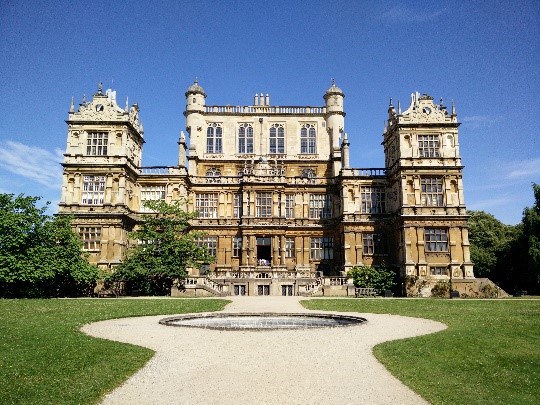
Wollaton was built by Sir Francis Willoughby, a great-great-grandson of Queen Elizabeth Woodville. The architect was probably Smythson, who worked with Sir William Cecil on his London home, as well as on Longleat. Willoughby, whose father and uncles had been clients of John Dudley, Duke of Northumberland, and involved in the ill-fated attempt to put Lady Jane Grey on the throne, had accumulated wealth through the development of coal-mines. By the time Anne arrived on 21st June, the house was occupied by Sir Francis’ daughter, Bridget, and her distant cousin and husband, Sir Percival Willoughby. Sir Percival had received his knighthood from James as the king had passed through Worksop a couple of months previously.
Wollaton Hall and Park is today in the care of Nottingham Council. It houses the county’s Natural History Museum, as well as some recreated seventeenth century interiors. It is free to visit and makes an excellent day out, only a few miles from Nottingham city centre.
As Anne travelled south, more members of the court came to greet her. She went to Althorp in Northamptonshire, where she was entertained with a masque, and then to Easton Neston (6) in the same county arriving there on 27th June, to be met by James. Easton Neston was built in the years after 1499, when Henry VII’s councillor, Sir Richard Empson, received a licence to empark – that is, enclose common land for a private park. The park took in some hundred acres, and in 1540 was recorded as having 33 deer.
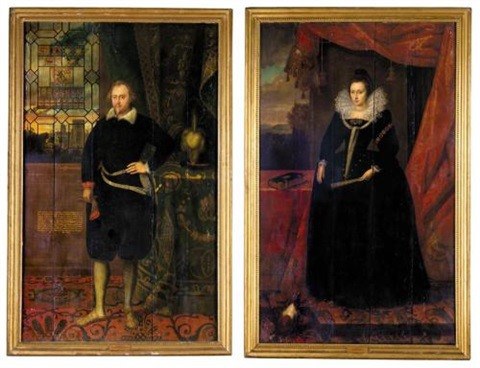
The gamepark at Easton Neston was commented on by a visitor from Moravia in 1600. He mentioned that the trees had been trained into arbours where the hunters could hide, to shoot the deer as they passed. As well as a deer park, Empson was allowed to crenellate his manor house, suggesting that he undertook expensive improvements. Building works continued throughout the first half of the sixteenth century. Elizabeth I visited several times, and Anne and James visited again after the first occasion. In around 1680, the old house was dismantled and a new house, which still stands, replaced it. Easton Neston descended through the Fermor family, who became Earls of Pomfret, and then to the Barons Hesketh. It was acquired in the 21st century by the Russian designer, Leon Max. It is not open to the public.
Anne’s long journey finished at Windsor Castle (7). Over the whole of James’ reign, the royal couple visited Windsor very frequently. Soon after their arrival in 1603, all the peeresses who had not formed part of the progress from Scotland were presented to their new queen. This was followed by a great installation feast which was held there when Prince Henry and Anne’s brother, Christian IV of Denmar,k were installed as Knights of the Order of the Garter. Prince Henry, in his new robes was presented to his mother. Lady Anne Clifford recorded the occasion in her journal:
‘I stood with my Lady Elizabeth’s Grace [the Princess], by the shrine in the Great Hall at Windsor to see the King and all the Knights sit at dinner. Then came the Archduke’s Ambassador who was received by the King and Queen in the Great Hall and there was such an infinite company of Lords and Ladies and so great a Court as I think I shall never see the like.’
Windsor today, of course, needs no description. It is both an official and private residence for HM The Queen, who spends most of her weekends there. The castle can be visited, and the Chapel where Prince Henry was invested as a Knight is open to the public. The castle is easily reached by train from London.
The court left Windsor for Hampton Court (10), to be closer to London for the coronation. Hampton Court was frequently used by Anne and it was there that she died in early 1619. Not long after their arrival, James created numerous new peers in the Great Hall, sitting under a Cloth of State, with Anne beside him. Among those promoted were Thomas Howard, who became Earl of Suffolk and Charles Blount, Lord Mountjoy, who was given the title of Earl of Devonshire (not Devon). Blount was widely known to be the lover of Lady Rich, one of Anne’s new ladies-in-waiting, and already a court favourite.
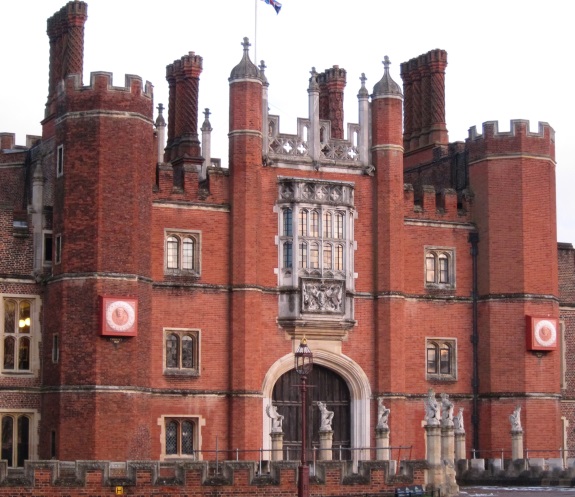
Hampton Court was shown off to King Christian during his visit in 1614, and it was at Hampton Court that the Conference was held resulting in the King James’ Authorised Version of the Bible. The palace was extensively remodelled and expanded in the time of Anne’s great-grandchildren – William III and Mary II, but much of the palace she would have known remains, including the Astronomical Clock. Today, Hampton Court is managed by Historic Royal Palaces, and much of it is open to the public.
Following their coronation at Westminster Abbey (11), (where the couple are also buried), James and Anne began their first summer progress. This was a tradition begun by Henry VIII and followed by Elizabeth I. It had a number of purposes – to allow the populace to see the monarch, to remove the court from London at the most unhealthy time of year, to indulge the royal taste for hunting, and to reduce crown expenses – although James and Anne were both extravagant and gave so much away in gifts and entertainments that there was little hope of reducing expenditure.
In their first summer progress, they visited Woodstock (8), amongst other places. Woodstock was a large estate consisting of several villages and woods, with a mediaeval hunting lodge, much frequented by monarchs since the days of Henry II. The post of Keeper of Woodstock was much sought after. Anne and James visited it frequently although it was not in particularly good repair, and many of the courtiers were obliged to sleep in tents. In 1611, the estate was granted to Prince Henry, and after his untimely death, to Prince Charles. In 1652, it was sold out of the royal estate by Parliament.
Fifty years later, the owners were compensated when Queen Anne (Anne of Denmark’s great-granddaughter) and Parliament, bestowed the lands on John Churchill, Duke of Marlborough in recognition of his victory at the Battle of Blenheim. The old palace was knocked down by the Duchess in 1720, after the extraordinary Blenheim Palace had been built to replace it. The location of the buildings Anne of Denmark would have known is marked with a stone, near the Vanburgh Bridge.
Anne’s first summer progress ended at Winchester (9), Hampshire, where the court remained for a couple of months, waiting for the plague to subside. They received two large silver cups and various gracious speeches from the mayor and corporation. Whilst at Winchester, James and Anne received an embassy from the King of Spain, along with pictures of his children. These were overtures for peace between England and Spain, after hostility that had lasted for over thirty years.
Whilst the court was at Winchester, James issued orders for the wardens and students of the college (now Winchester School) to vacate their rooms to enable various law officers and other officials to occupy them during the trial of Sir Walter Raleigh, Lord Cobham and others for complicity in the Main Plot. The trial had been moved to Winchester as London was still a hotbed of contagion.
Rather than being crown property, the castle belonged to the See of Winchester, although it was often visited by mediaeval monarchs. It was the location for the births of Henry III, and Arthur, Prince of Wales, son of Henry VII and Elizabeth of York, and for Mary I’s first meeting with her bridegroom, Philip of Spain. The majority of the mediaeval castle was dismantled during the Civil War. Today, the Great Hall remains, and houses the Winchester museum.
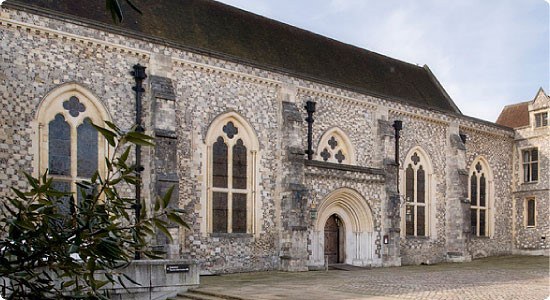
Another of the locations in Hampshire that Anne visited the first summer she was queen, and on several other occasions, was Wilton House (12). Wilton was the home of Mary Herbert (née Sidney), Countess of Pembroke. Lady Pembroke was at the centre of a circle of poets and scholars, which had included her brother, Sir Philip Sidney, whose work ‘The Countess of Pembroke’s Arcadia’ had originally been written for her. Lady Pembroke herself was an extremely accomplished author and translator. It is likely that on this first visit to Wilton, Anne saw Shakespeare perform ‘As You Like It’ for which the actors were paid £30.
Anne, however, came to patronise another of Lady Pembroke’s protegés more extensively – Ben Johnson. Johnson wrote numerous masques for Anne over the following years.
Wilton was once one of the most important Benedictine convents in England. It had been the convent of choice for the daughters of England’s Saxon kings and the Abbess held a barony. The convent was surrendered on 25th March 1539, and the lands were granted in 1551 to William Herbert, husband of Anne Parr. Herbert, shortly after promoted to the Earldom of Pembroke, built an enormous mansion, of which only the central tower survives. This is the house that Anne would have known, but it was largely replaced after 1630. Still owned by the Earls of Pembroke, Wilton is open to the public.
Close to the capital, Anne used Hampton Court, Richmond and Greenwich. Greenwich (13) was the location for the birth of her daughter, Mary, on 8th April 1604 – the first birth of a child to a Queen Consort in England since 1537. The following year, Greenwich was the scene of the Garter feast, at which Anne’s brother, Duke Ulrich of Holstein, was invested with the Order. Following shortly after, Cecil was created Earl of Salisbury, and his half-brother, Earl of Exeter, whilst Lady Pembroke’s younger son received the Earldom of Montgomery.
In 1617, a Mr Chamberlain wrote to Sir Dudley Carleton that Anne was building at Greenwich. He described the plan as ‘a curious device’ of Inigo Jones, to be finished that summer at a cost of £4,000. In fact, the building was not completed before Anne’s death, and the architectural gem known as the Queen’s House was completed around 1630 for her daughter-in-law, Queen Henrietta Maria. Jones’ drawings are in the collection at the V&A.
One of the favourite locations of Anne and James was the magnificent house at Theobalds (14). This had been built for Sir William Cecil, Lord Burghley, Elizabeth’s chief minister, and descended to his second son, the Earl of Salisbury. Anne and James visited it frequently. Located near Cheshunt in Hertfordshire – now a part of London, on the A10 heading north – it was the most fabulous of all Elizabeth’s courtiers’ houses.
It was at Theobalds that James entertained Anne’s brother, Christian IV, in 1604, and by 1607 the royal couple liked it so much that it was exchanged for Hatfield palace, part of Anne’s jointure. The house was demolished by Parliament after the Civil War, and only traces of the gatehouse remain.
In 1613, mourning the death of her son, Anne went on progress to Bath to take the waters, perhaps in hopes that a change of scene would help. She certainly undertook the trip in grand style, and it was estimated that the whole progress cost £30,000. Anne was accompanied by the Lord Chancellor, the Countesses of Worcester and Derby, the Earl of Worcester, Lord Danvers and various other nobles. James accompanied her as far as Hampton Court (10), whence she travelled to Windsor (7), to Reading and then to the home of William, Lord Knollys, at Caversham Park. At Caversham a masque was presented, written by Thomas Campion, and performed by her hostess’ four brothers and other gentlemen.
Anne arrived in Bath a few weeks later. The belief in the curative powers of spring waters was increasing, and Bath had two public baths for medicinal purposes, the King’s Bath, and the New Bath, built some years before by a Mr Bellot. According to an old story, whilst Anne was in the King’s Bath, a flame shot up and covered the surface before quickly extinguishing itself. Anne was assured that this was a perfectly natural occurrence, but she was not convinced. She refused to return to the King’s Bath, and insisted on using the New Bath, which became known as the Queen’s Bath from that time. The baths at Bath are open to the public – although the pools that Anne used are not safe, and newer ones have been created.
On leaving Bath, Anne went to Bristol and from there to Wells (15), arriving on 20th July, where she lodged in the Bishop’s Palace, adjacent to the Cathedral. Wells is a small cathedral city, a truly delightful place to visit now, and probably equally delightful in the seventeenth century – especially as orders had been given by the Bishop that the streets should be cleared of ‘beggars and rogues’ and the streets ‘pitched’.
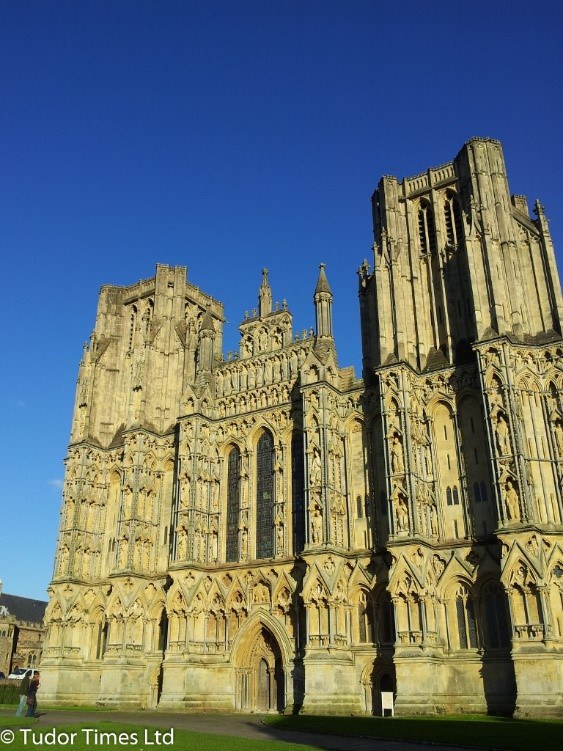
The Mayor and Aldermen were to greet the Queen in their scarlet gowns, with the rest of the burgesses in their best clothes, with black gowns. Each of the city companies (the different trades) presented a tableau – the Carpenters; the Shearmen and Tuckers; the Tanners, Chandlers and Butchers; the Cordwainers; the Tailors and the Mercers all played their parts. Hopefully, Anne enjoyed their efforts as much as she did those of more sophisticated performers!
The map below shows the location of the places associated with Anne of Denmark discussed in this article.
